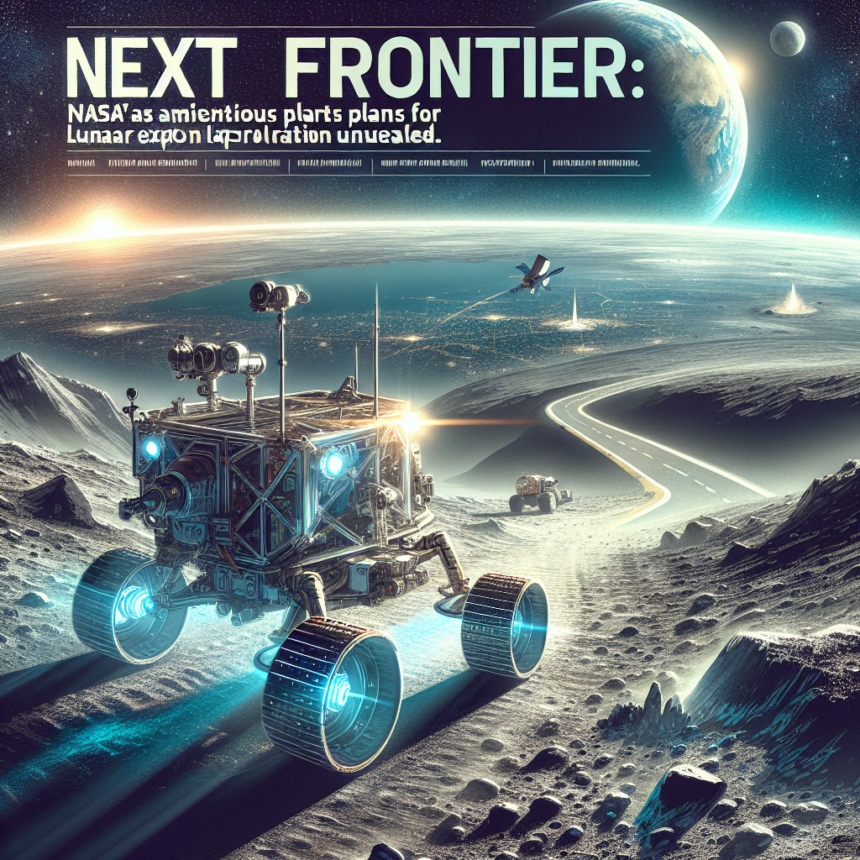Next Frontier: NASA’s Ambitious Plans for Lunar Exploration Unveiled
As humanity advances into the 21st century, the allure of the cosmos continues to captivate our imagination. In the spirit of boundless exploration, NASA has unveiled its ambitious plans for lunar exploration—plans that aim to not only return humans to the Moon but to establish a sustainable presence and lay the groundwork for future missions to Mars and beyond.
The Artemis Program: A New Dawn for Lunar Exploration
At the heart of NASA’s lunar ambitions is the Artemis program, named after the Greek goddess of the Moon and twin sister of Apollo. This initiative marks a significant shift from the Agency’s previous moon missions in the 1960s and 70s. While Apollo was focused primarily on landing astronauts on the lunar surface, Artemis aims to establish a long-term human presence on the Moon.
NASA’s goal is to land the first woman and the next man on the lunar surface by the mid-2020s. To achieve this, the agency has outlined a detailed roadmap that includes not just landing but also ongoing exploration and habitation on the Moon. Artemis will serve as a stepping stone for further exploration of Mars, which is a primary focus for NASA’s future manned spaceflight missions.
Key Components of the Artemis Program
-
Artemis I: The first phase of the program, Artemis I, is an uncrewed test flight of the Space Launch System (SLS) rocket and the Orion spacecraft. Scheduled for late 2021, Artemis I will orbit the Moon and return to Earth, testing critical technologies and systems for future crewed missions.
-
Artemis II: This mission will be a crewed flight around the Moon, allowing NASA to assess performance and safety. Astronauts will conduct vital operations in lunar orbit, paving the way for subsequent lunar landings.
-
Artemis III: Targeted for 2025, Artemis III is expected to involve landing astronauts on the lunar South Pole, an area rich in water ice and other resources. This mission will also include advancements in lunar landing technologies and will utilize the Human Landing System (HLS) developed by commercial partners.
-
Lunar Gateway: An integral part of the Artemis plan, the Lunar Gateway will serve as a space station in lunar orbit. This outpost will support lunar surface missions, provide a staging point for Martian missions, and enable ongoing scientific research.
- Sustainable Exploration: NASA’s plans for lunar exploration also focus on sustainability. The agency aims to establish a base camp on the lunar surface and utilize in-situ resource utilization (ISRU) techniques. This means using local materials to produce water, oxygen, and fuel, thus reducing the need for supplies from Earth.
Scientific Research and Collaboration
NASA’s lunar exploration will not only advance human space travel but also serve as a platform for scientific discovery. The Moon provides a unique environment for studying geology, resource distribution, and the effects of low gravity on human biology. The data collected will enhance our understanding of planetary processes and the history of our solar system.
Additionally, NASA is promoting international and commercial partnerships to foster collaboration. Countries like Canada, Japan, and the European Space Agency (ESA) are already engaging in cooperative efforts, contributing to various aspects of the Artemis missions.
What Lies Ahead?
The next decade promises to be transformative for lunar exploration. Beyond establishing a permanent human presence on the Moon, NASA envisions broader ambitions, including exploration of Mars and beyond. The technologies and methodologies developed during the Artemis missions will undoubtedly shape the future of space exploration.
To assist readers with understanding the key points of NASA’s lunar exploration plans, here are some frequently asked questions:
FAQs
Q: What is Artemis?
A: The Artemis program is NASA’s initiative aimed at returning humans to the Moon, specifically to the lunar South Pole, with a goal of establishing a sustainable presence on the lunar surface.
Q: When will astronauts return to the Moon?
A: NASA aims to land astronauts on the Moon by 2025 as part of the Artemis III mission.
Q: What is the Lunar Gateway?
A: The Lunar Gateway is a planned space station that will orbit the Moon, serving as a hub for lunar exploration and a platform for future missions to Mars.
Q: How will NASA sustain its lunar presence?
A: NASA’s approach includes utilizing local resources found on the Moon, employing in-situ resource utilization (ISRU) to produce essentials like water and oxygen.
Q: Can other countries participate in the Artemis program?
A: Yes, NASA is collaborating with international partners, allowing contributions from agencies like ESA, JAXA (Japan), and others for the construction and operation of the Artemis missions.
In conclusion, NASA’s ambitious plans for lunar exploration mark the beginning of a new era, one that aims to extend humanity’s reach into the cosmos while inviting global collaboration and scientific discovery. As we stand on the brink of unprecedented achievements, our journey to the Moon and beyond is destined to redefine our place in the universe.









